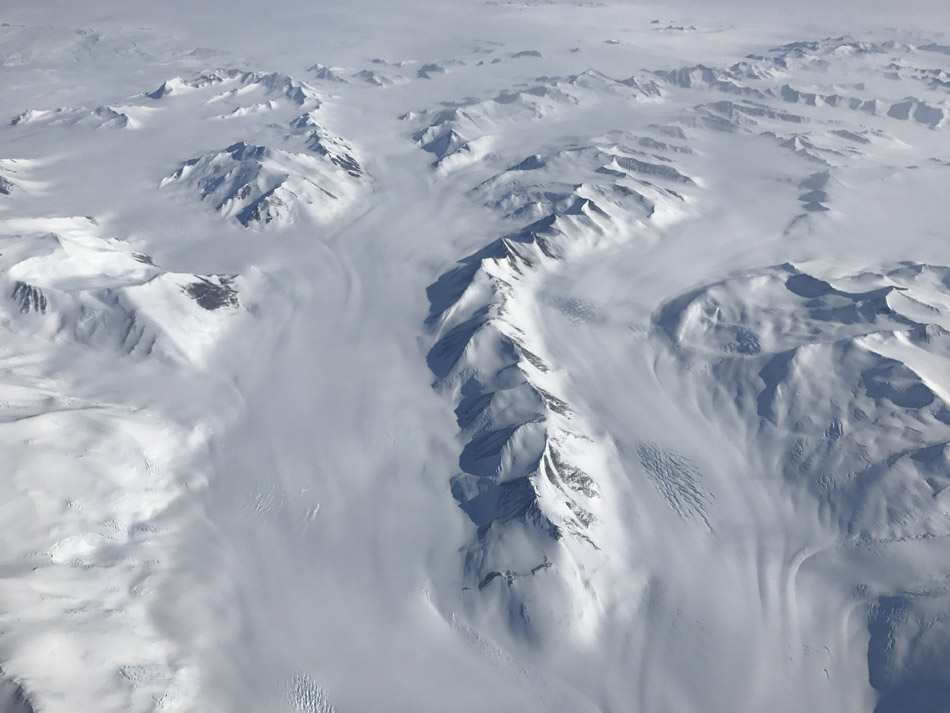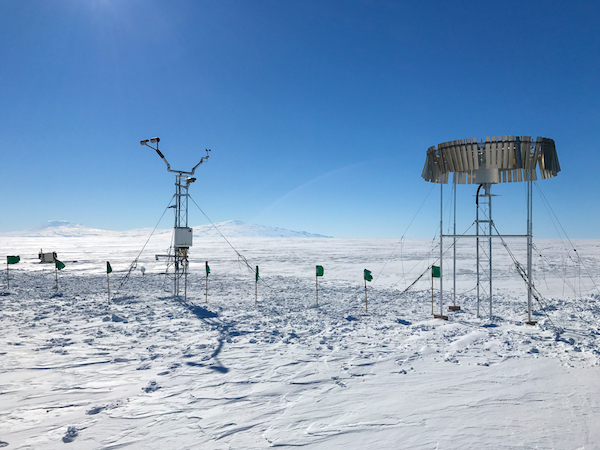Measuring snowfall in Antarctica
Discovering how much snow is falling on the world's coldest, windiest continent
Jun 5, 2018 - by Ali Branscombe
Jun 5, 2018 - by Ali Branscombe

Antarctica is one of the snowiest and windiest places on Earth, making it difficult for researchers to measure the amount of snow that is falling, and then becoming part of, the Antarctic ice sheets. A team of researchers have set up the first advanced suite of snowfall measuring tools in this harsh environment. (Image: Scott Landolt.)
Less than a year ago, an iceberg the size of the state of Delaware calved off an Antarctic ice shelf into the Weddell Sea, taking the final step in the slow but inevitable march of the ice sheet toward the ocean.
Observers have long tracked the ice sheets to the ocean's edge, but little is known about the origins of these frozen formations. Scientists are interested in determining how much snowfall is feeding the ice sheets, and whether that amount offsets the frozen water lost to the ocean each year. For researchers studying the impacts of global climate change on the polar ice sheets, this data could help predict the future of Antarctica’s ice — and the world's coastlines. According to the National Snow and Ice Data Center, if the Antarctic Ice Sheet ever fully melted without being replenished, global sea level would rise about 200 feet (60 meters).
"We have a good idea of how much ice is being lost," said NCAR scientist Scott Landolt. "What we don’t have a good handle on is how much snow is accumulating to offset the ice loss."
To find the answers, Landolt and his team have just set up the first suite of advanced snowfall measuring tools in Antarctica. The goal is to get a picture of the snowfall budget feeding the ice sheets that hold approximately 90 percent of the world’s ice. The project is funded by the National Science Foundation, which is NCAR’s sponsor.
Going to the snowiest landscape on Earth was the research trip of a lifetime for Landolt, who has been conducting snowfall measurements in the United States for 20 years. "Antarctica is the holy grail of snowfall measurement," he said.
When snow falls in Antarctica, a variety of factors can compress it into ice that then slowly crawls toward the ocean. To understand how much snow is contributing to the ice sheet, researchers must measure the amount of water actually frozen in the snowflakes, referred to as the liquid water equivalent. The liquid water equivalent is very challenging to measure, and until now there have been few attempts by Antarctic researchers to do so.
The challenge arises as snow falls. It is lighter than rain and therefore more likely to fall along a path dictated by blowing wind. To make things more difficult, once a snowflake reaches the ground it could then be picked up by the wind and blown for miles before finally settling down.
With collaborators Mark Seefeldt and Andrew Monaghan, both at the University of Colorado Boulder, Landolt had to design a system that can make the distinction between falling snow and blowing snow. The system also had to withstand hurricane-force winds and temperatures well below -40 degrees (Fahrenheit/Celsius). "We have refined our techniques over the years doing local research on snowfall measurement, and we know the cutting edge of technology for doing this," said Landolt. "Now we are going to take on the real challenge of doing this in ridiculously windy and ridiculously cold conditions and try to get meaningful data out of that."

In November 2017, Landolt and his team, which included technical support from UNAVCO, set up a suite of specially tailored snow measurement tools at four precipitation monitoring stations in Antarctica. The tools measure snow height, snow mass (to determine the liquid water equivalent), snowflake size, wind speed, and the number of snowflakes that fall in a given amount of time. The researchers also set up a webcam to keep an eye on their weather stations. The entire suite runs on just three watts of power per year, the equivalent of powering a small light bulb for the same amount of time.
Snow mass is the key measurement that helps researchers estimate the liquid water equivalent going into the ice sheet. These data are collected using a bucket inside a precipitation gauge that sits on a very sensitive mass balance. The precipitation gauge is encircled by two concentric wind shields designed to slow wind down, minimizing gusting winds that can blow the snow around and over the bucket. The shields help direct the snow to fall into the gauge. Once snow has accumulated in the bucket, the researchers can measure the mass and convert it to the liquid water equivalent.
Preliminary measurements from the sites are already revealing more of the Antarctic’s story. Landolt’s team noticed that after a snowfall event, the measurement devices show signs of snow sublimating — the process of going directly from solid snowflakes to water vapor. Landolt pointed to an example of a snowfall that accumulated 0.2 inches of liquid water equivalent, but then slowly sublimated out over the course of two weeks. This could mean that less Antarctic snow may be feeding ice sheets than previously thought.
"This is one cool thing about the project that we did not set out to measure but we will report on," said Landolt. "There have been estimates of how much snow is sublimating, but to my knowledge, nobody has actually really measured this before."
The team has two more trips to the Antarctic sites scheduled: a maintenance trip later this year, and a tentative sensor removal trip in 2019. If the data from the weather stations is sound, the next step would be to integrate the technology into existing Antarctic weather stations. Once the data is analyzed, the team expects this work to help climate scientists adjust models of climate change and sea level rise.
"If this works, the goal would be to get more stations across Antarctica, which would contribute to more accurate snowfall modeling," said Landolt. "There are worldwide impacts to the research we are doing."
